Influence of Longitudinal Wind on Hydrogen Leakage and Hydrogen Concentration Sensor Layout of Fuel Cell Vehicles
Abstract
:1. Introduction
- (1)
- By studying the simulation results of hydrogen leakage under different longitudinal wind speeds and leakage locations, the influence of longitudinal wind on hydrogen leakage and diffusion is found.
- (2)
- A scene clustering method based on vector similarity evaluation is proposed, which eliminates duplicate leakage trajectories and reduces the computational complexity of subsequent sensor position optimization.
- (3)
- Regarding the optimization of the HCS position for FCVs under the longitudinal wind scene, a multi-scene full coverage response time minimization model is proposed.
2. Hydrogen Leakage Model and Parameter Settings
2.1. Problem Description
2.2. Simulation Settings and Boundary Conditions
3. Concentration Distribution Simulation
3.1. Simulation Verification
3.2. Simulation Result Analysis
4. Sensor Layout Optimization
4.1. Leakage Scene Clustering Analysis
4.2. Sensor Layout Optimization Method
5. Conclusions
- (1)
- The longitudinal wind prolongs the diffusion time of hydrogen to the headspace, and the coverage area of hydrogen in the headspace decreases. After five seconds of leakage, the average coverage rate reached 98.58% in windless conditions, only 36.92% at 37.18 km/h, and even decreased to 18.38% at 114 km/h, with a decrease of 81.35%.
- (2)
- At the beginning of different leakage scenarios, the similarity between the leakage scenarios is poor because of the different leakage locations and longitudinal winds. However, as the FCC and HSTC are semi-closed spaces, with the increase in leakage time, the similarity of hydrogen diffusion trajectories in the cabin is enhanced, and the number of clustered scenarios is gradually reduced, from the initial 15 to 10, with a decrease of 33.33%. The coverage rate of the leakage space after clustering is not lower than 82.67% of the original leakage space, which shows that the clustering result can better represent the original whole scene set.
- (3)
- Optimizing the position of HCSs. After optimization, the sensor position is highly coincident with several main vortex positions in the longitudinal wind scene, and the response time of the hydrogen leakage is shortened from 5 s to 1 s.
- (1)
- Considering more longitudinal wind speeds in the simulation, and adding the longitudinal wind angle to make the data of the leakage scene set more perfect.
- (2)
- When the FCV is running, the fuel cell stack will generate huge heat to change the temperature distribution in the FCC, and the hydrogen leakage and diffusion caused by the temperature gradient distribution in the FCC have not been considered yet.
Author Contributions
Funding
Institutional Review Board Statement
Informed Consent Statement
Data Availability Statement
Conflicts of Interest
References
- Hu, D.; Wang, Y.; Li, J.; Yang, Q.; Wang, J. Investigation of optimal operating temperature for the PEMFC and its tracking control for energy saving in vehicle applications. Energy Convers. Manag. 2021, 249, 114842. [Google Scholar] [CrossRef]
- Li, Y.; Kimura, S. Economic competitiveness and environmental implications of hydrogen energy and fuel cell electric vehicles in ASEAN countries: The current and future scenarios. Energy Policy 2021, 148, 111980. [Google Scholar] [CrossRef]
- Xie, Y.; Lv, N.; Huang, Y.; Wu, D.; Gong, L.; Yang, X.; Zeng, Y. Comparative analysis on temperature characteristics of hydrogen-powered and traditional fossil-fueled vehicle fires in the tunnel under longitudinal ventilations. Int. J. Hydrogen Energy 2022, 47, 24107–24118. [Google Scholar] [CrossRef]
- Zeng, T.; Zhang, C.; Hao, D.; Cao, D.; Chen, J.; Chen, J.; Li, J. Data-driven approach for short-term power demand prediction of fuel cell hybrid vehicles. Energy 2020, 208, 118319. [Google Scholar] [CrossRef]
- Andersson, J.; Grönkvist, S. Large-scale storage of hydrogen. Int. J. Hydrogen Energy 2019, 44, 11901–11919. [Google Scholar] [CrossRef]
- Fan, L.; Tu, Z.; Chan, S.H. Recent development of hydrogen and fuel cell technologies: A review. Energy Rep. 2021, 7, 8421–8446. [Google Scholar] [CrossRef]
- Li, Y.; Hou, X.; Wang, C.; Wang, Q.; Qi, W.; Li, J.; Zhang, X. Modeling and analysis of hydrogen diffusion in an enclosed fuel cell vehicle with obstacles. Int. J. Hydrogen Energy 2022, 47, 5745–5756. [Google Scholar] [CrossRef]
- Moradi, R.; Growth, K.M. Hydrogen storage and delivery: Review of the state of the art technologies and risk and reliability analysis. Int. J. Hydrogen Energy 2019, 44, 12254–12269. [Google Scholar] [CrossRef]
- Xie, Y.; Lv, N.; Wang, X.; Wu, D.; Wang, S. Thermal and fire characteristics of hydrogen jet flames in the tunnel at longitudinal ventilation strategies. Fuel 2021, 306, 121659. [Google Scholar] [CrossRef]
- Yu, X.; Wang, C.; He, Q. Numerical study of hydrogen dispersion in a fuel cell vehicle under the effect of ambient wind. Int. J. Hydrogen Energy 2019, 44, 22671–22680. [Google Scholar] [CrossRef]
- Mo, F.; Liu, B.; Wang, H.; She, X.; Teng, L.; Kang, X. Study on hydrogen dispersion in confined space with complex air supply and exhaust system. Int. J. Hydrogen Energy 2022, 47, 29131–29147. [Google Scholar] [CrossRef]
- Gu, X.; Zhang, J.; Pan, Y.; Ni, Y.; Ma, C.; Zhou, W.; Wang, Y. Hazard analysis on tunnel hydrogen jet fire based on CFD simulation of temperature field and concentration field. Saf. Sci. 2020, 122, 104532. [Google Scholar] [CrossRef]
- Wang, T.; Yang, F.; Hu, Q.; Hu, S.; Li, Y.; Ouyang, M. Experimental and simulation research on hydrogen leakage of double ferrule joints. Process Saf. Environ. Prot. 2022, 160, 839–846. [Google Scholar] [CrossRef]
- Malakhov, A.; Avdeenkov, A.; Du Toit, M.; Bessarabov, D. CFD simulation and experimental study of a hydrogen leak in a semi-closed space with the purpose of risk mitigation. Int. J. Hydrogen Energy 2020, 45, 9231–9240. [Google Scholar] [CrossRef]
- Giannissi, S.G.; Tolias, I.C.; Melideo, D.; Baraldi, D.; Shentsov, V.; Makarov, D.; Molkov, V.; Venetsanos, A.G. On the CFD modelling of hydrogen dispersion at low-Reynolds number release in closed facility. Int. J. Hydrogen Energy 2021, 46, 29745–29761. [Google Scholar] [CrossRef]
- Hao, D.; Wang, X.; Zhang, Y.; Wang, R.; Chen, G.; Li, J. Experimental Study on Hydrogen Leakage and Emission of Fuel Cell Vehicles in Confined Spaces. Automot. Innov. 2020, 3, 111–122. [Google Scholar] [CrossRef]
- Liang, Y.; Pan, X.; Zhang, C.; Xie, B.; Liu, S. The simulation and analysis of leakage and explosion at a renewable hydrogen refuelling station. Int. J. Hydrogen Energy 2019, 44, 22608–22619. [Google Scholar] [CrossRef]
- Tsunemi, K.; Kihara, T.; Kato, E.; Kawamoto, A.; Saburi, T. Quantitative risk assessment of the interior of a hydrogen refueling station considering safety barrier systems. Int. J. Hydrogen Energy 2019, 44, 23522–23531. [Google Scholar] [CrossRef]
- To, C.W.; Chow, W.K.; Cheng, F.M. Simulation of Possible Fire and Explosion Hazards of Clean Fuel Vehicles in Garages. Sustainability 2021, 13, 12537. [Google Scholar] [CrossRef]
- Lv, H.; Shen, Y.H.; Zheng, T.; Zhou, W.; Ming, P.W.; Zhang, C.M. Numerical study of hydrogen leakage, diffusion, and combustion in an outdoor parking space under different parking configurations. Renew. Sustain. Energy Rev. 2023, 173, 113093. [Google Scholar] [CrossRef]
- Chauhan, P.S.; Bhattacharya, S. Hydrogen gas sensing methods, materials, and approach to achieve parts per billion level detection: A review. Int. J. Hydrogen Energy 2019, 44, 26076–26099. [Google Scholar] [CrossRef]
- Tian, Y.; Zou, Q.; Lin, Z. Hydrogen Leakage Diagnosis for Proton Exchange Membrane Fuel Cell Systems: Methods and Suggestions on Its Application in Fuel Cell Vehicles. IEEE Access 2020, 8, 224895–224910. [Google Scholar] [CrossRef]
- Tian, Y.; Zou, Q.; Jin, Z.; Lin, Z. Data-driven diagnosis of the high-pressure hydrogen leakage in fuel cell vehicles based on relevance vector machine. Int. J. Hydrogen Energy 2022, 47, 12281–12292. [Google Scholar] [CrossRef]
- De Stefano, M.; Rocourt, X.; Sochet, I.; Daudey, N. Hydrogen dispersion in a closed environment. Int. J. Hydrogen Energy 2019, 44, 9031–9040. [Google Scholar] [CrossRef]
- GB/T 24549—2020; Fuel Cell Electric Vehicles—Safety Requirements. Standardization Administration of the People’s Republic of China: Beijing, China, 2020.
- Zhang, C.; Cao, X.; Bujlo, P.; Chen, B.; Zhang, X.; Sheng, X.; Liang, C. Review on the safety analysis and protection strategies of fast filling hydrogen storage system for fuel cell vehicle application. J. Energy Storage 2022, 45, 103451. [Google Scholar] [CrossRef]
- Kobayashi, H.; Naruo, Y.; Maru, Y.; Takesaki, Y.; Miyanabe, K. Experiment of cryo-compressed (90-MPa) hydrogen leakage diffusion. Int. J. Hydrogen Energy 2018, 43, 17928–17937. [Google Scholar] [CrossRef]
- Merilo, E.G.; Groethe, M.A.; Colton, J.D.; Chiba, S. Experimental study of hydrogen release accidents in a vehicle garage. Int. J. Hydrogen Energy 2011, 36, 2436–2444. [Google Scholar] [CrossRef]
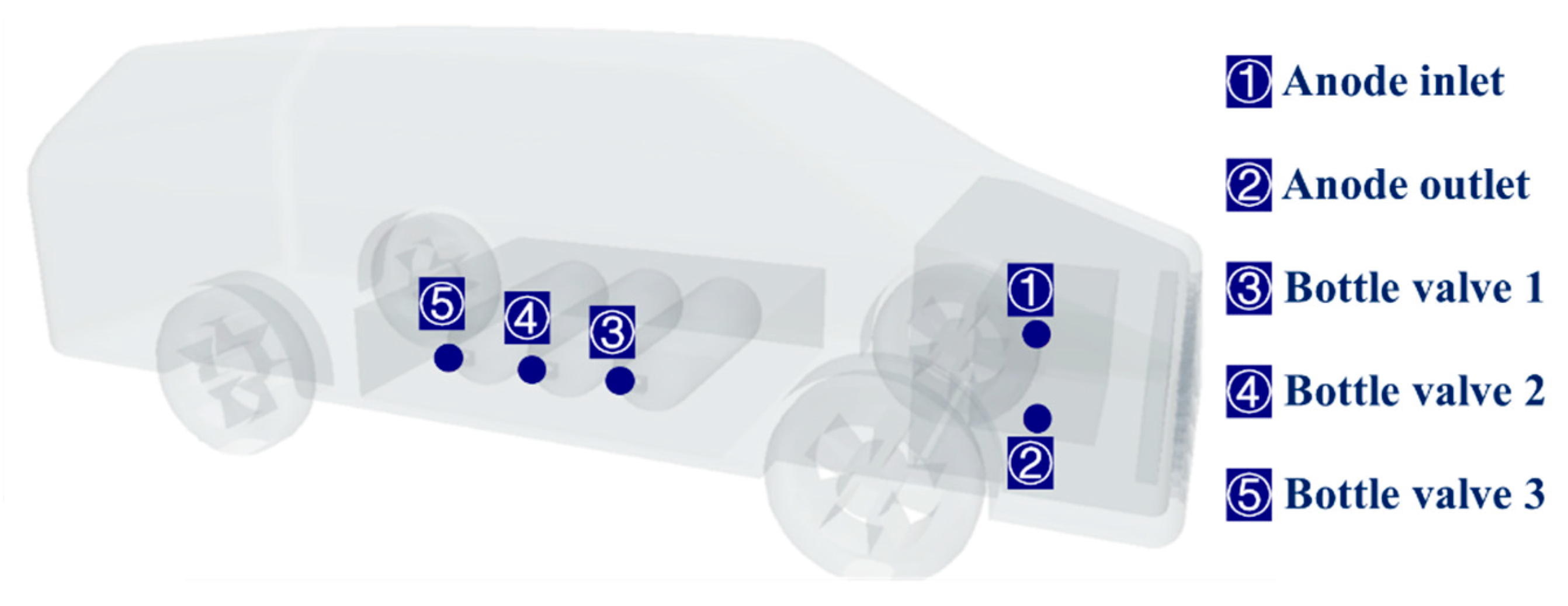

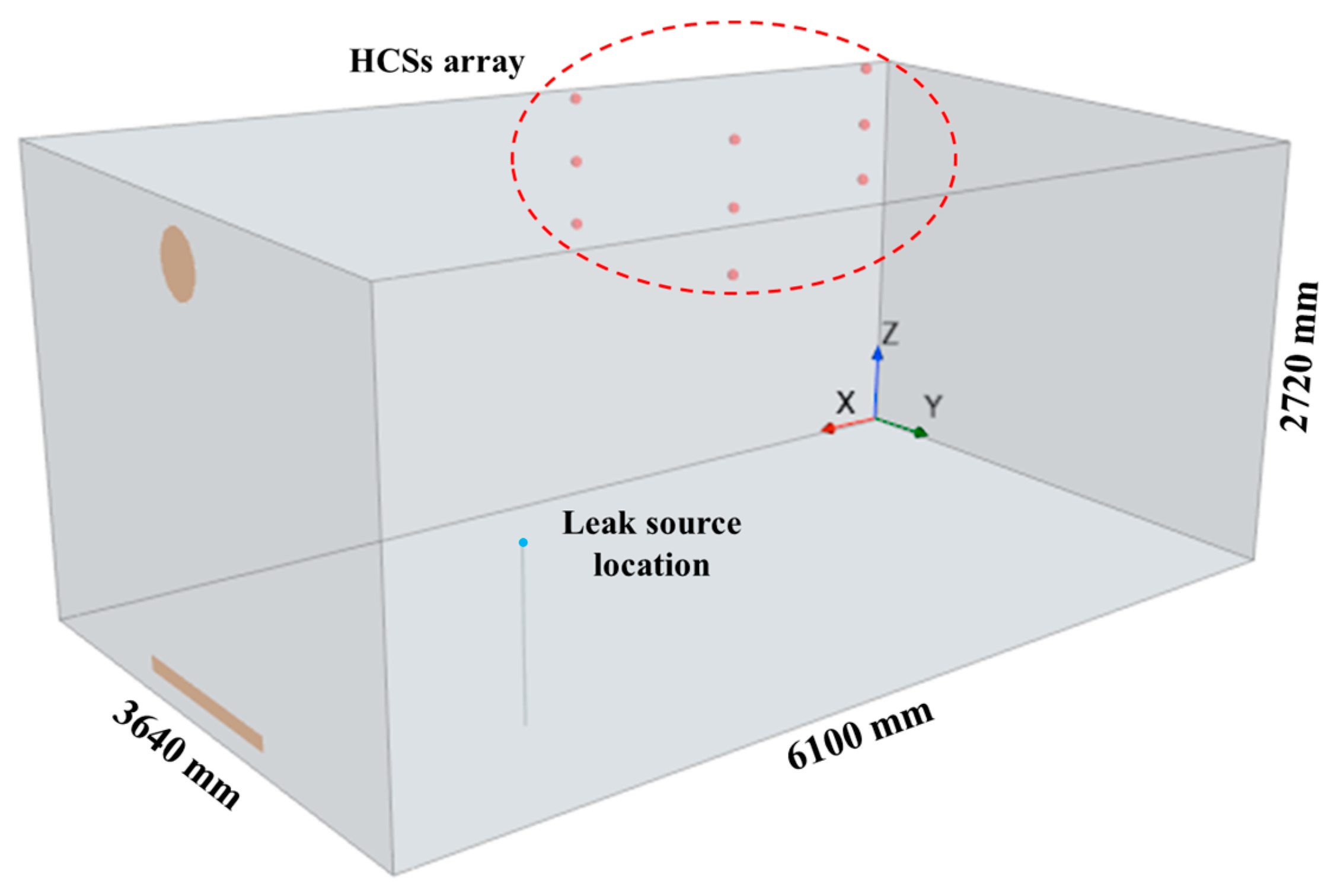


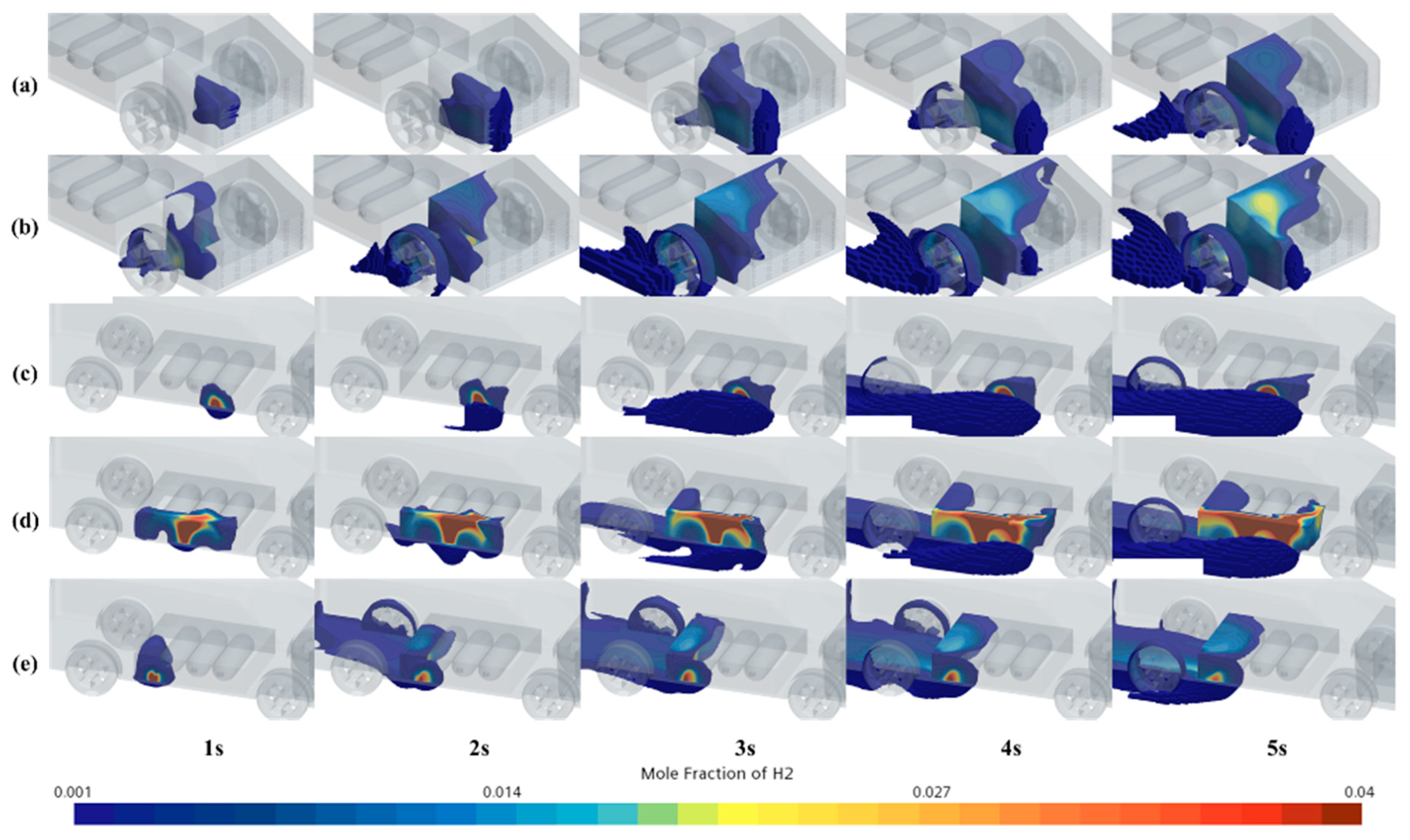
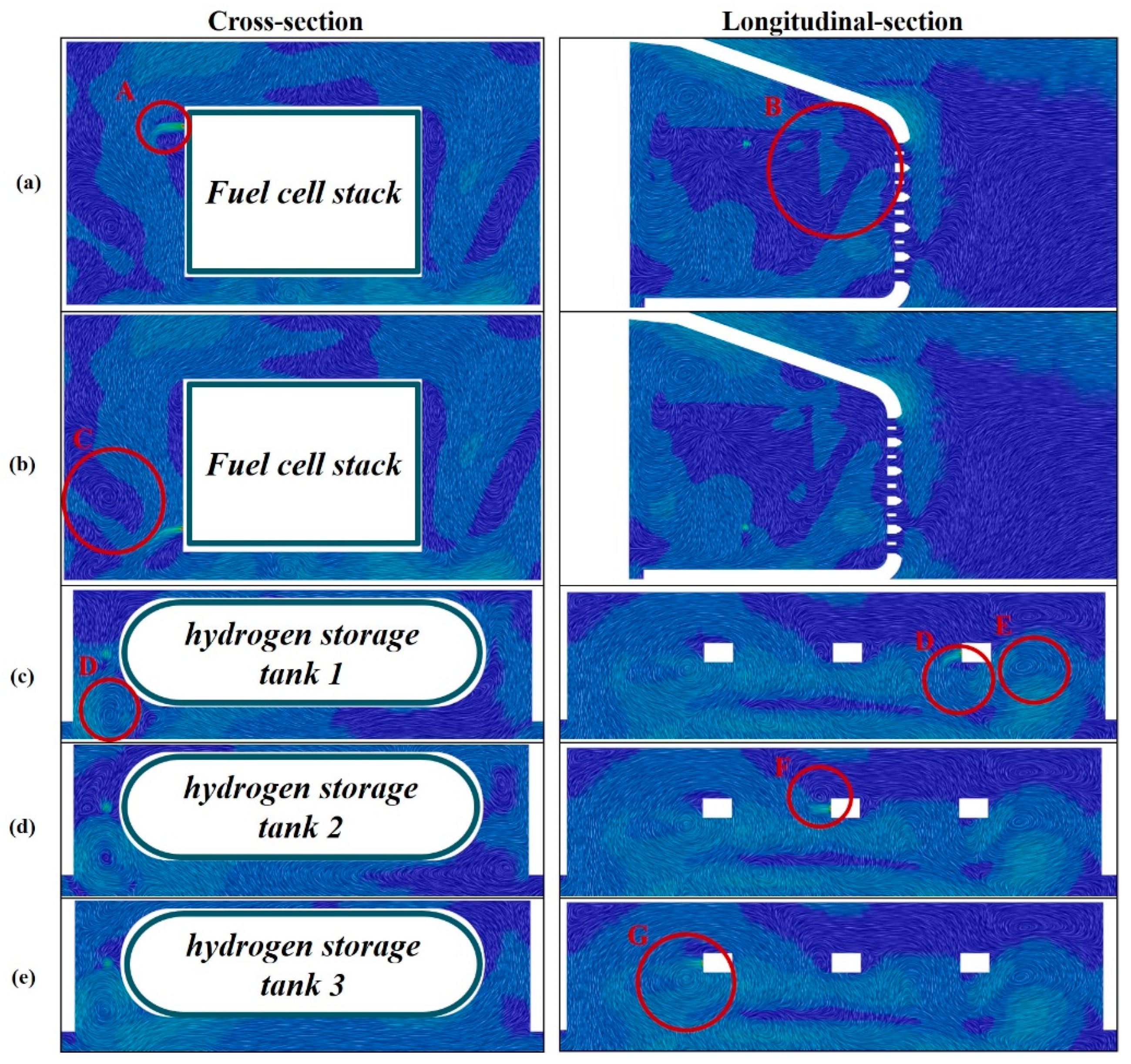
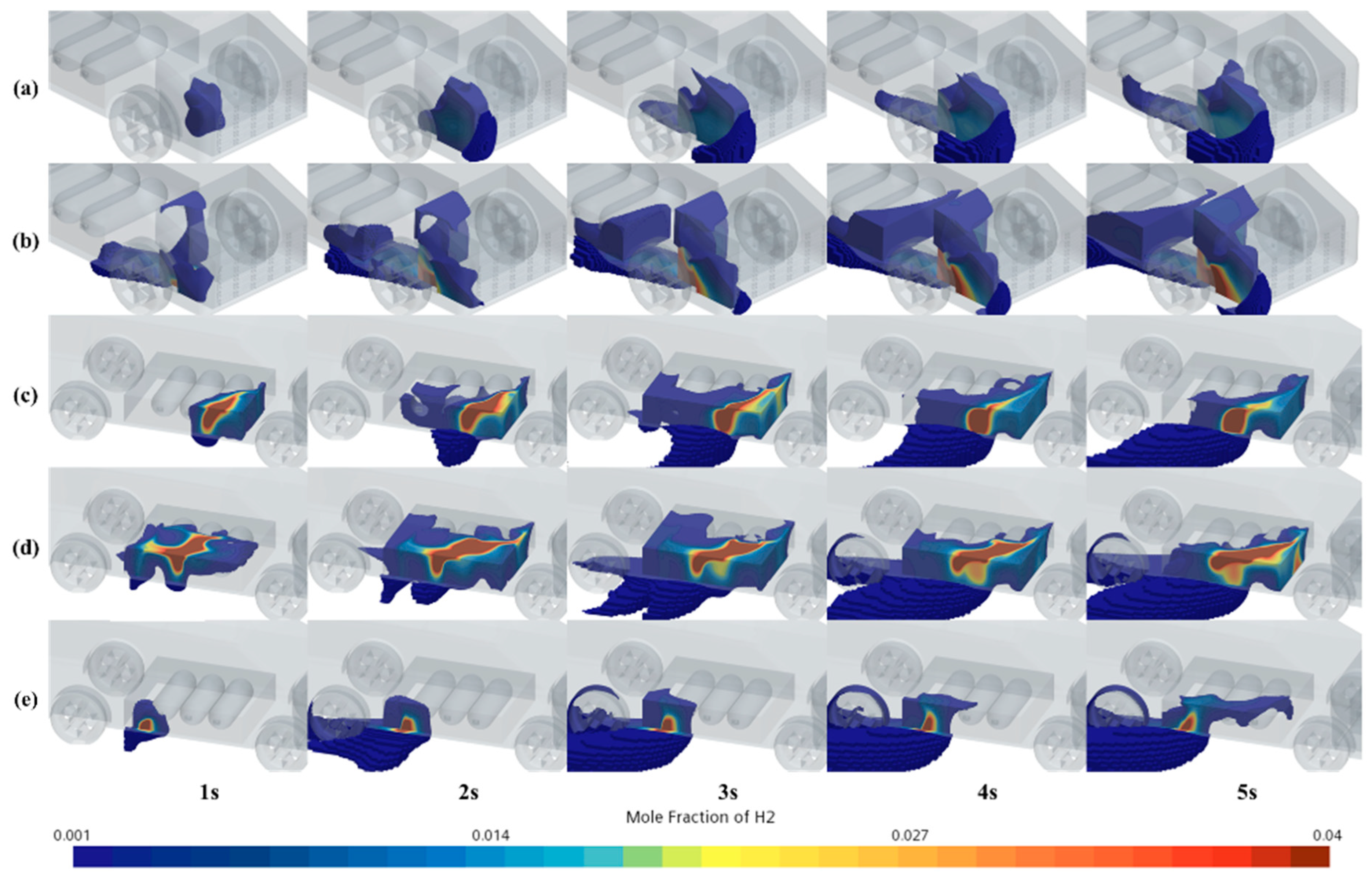
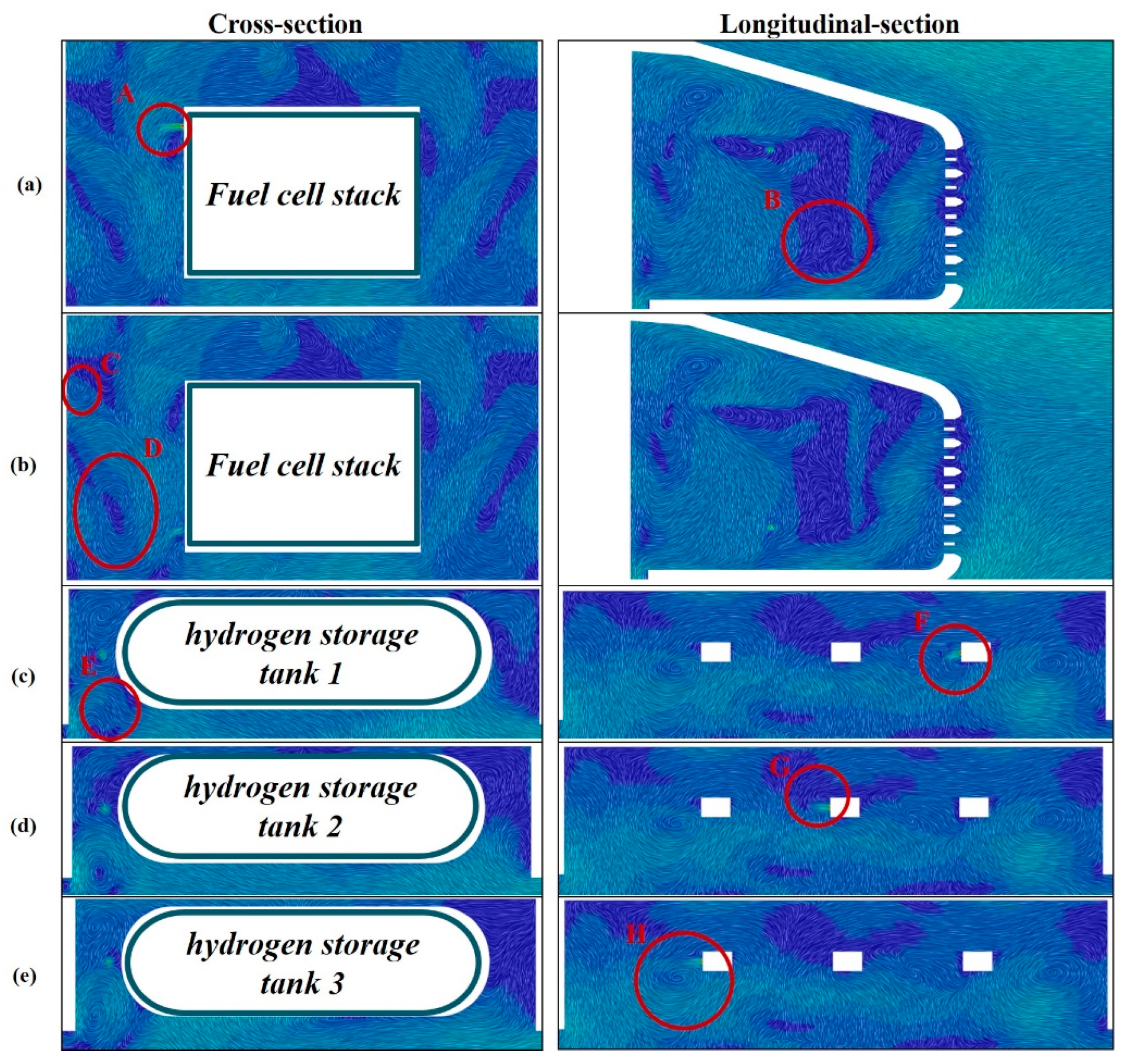



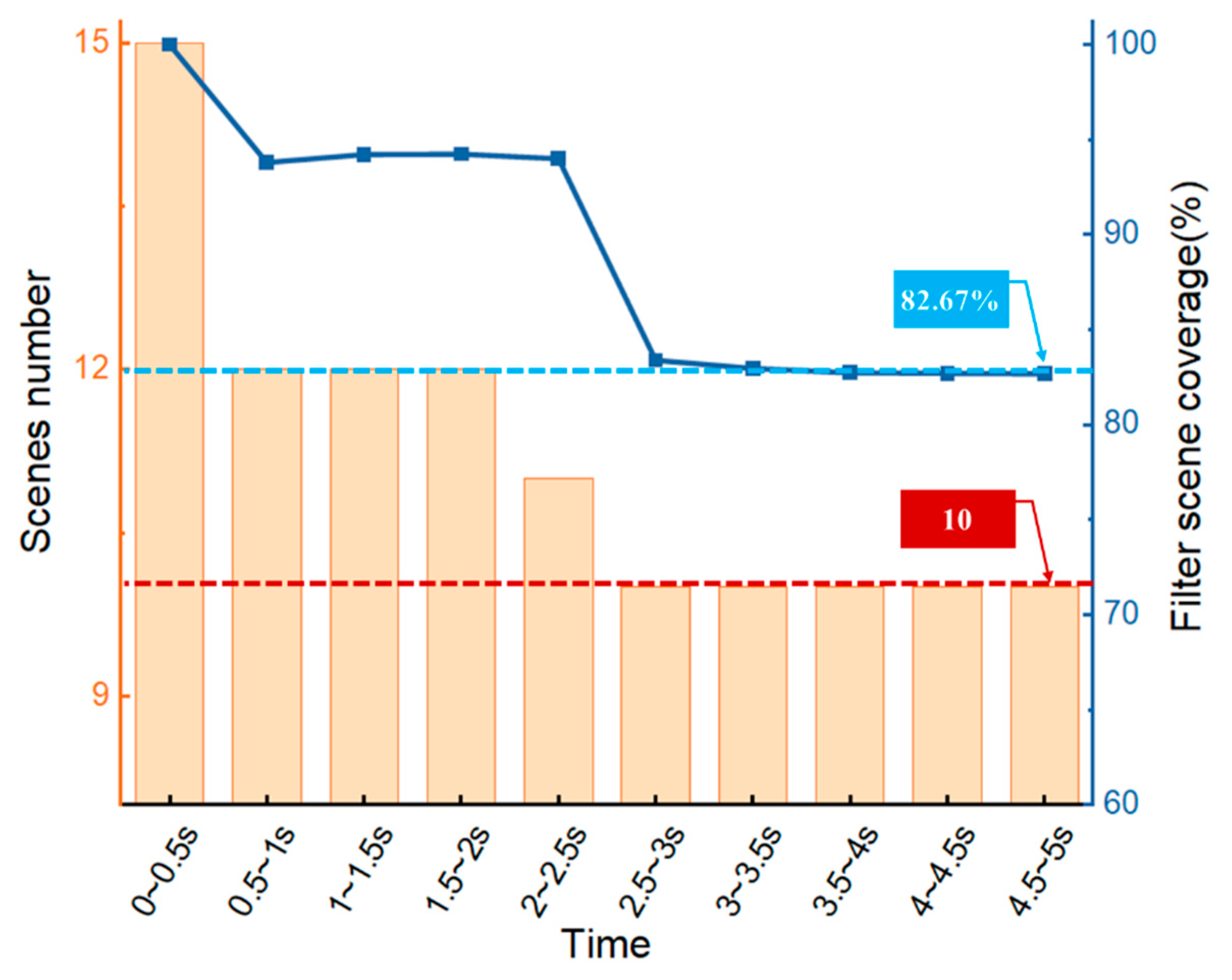
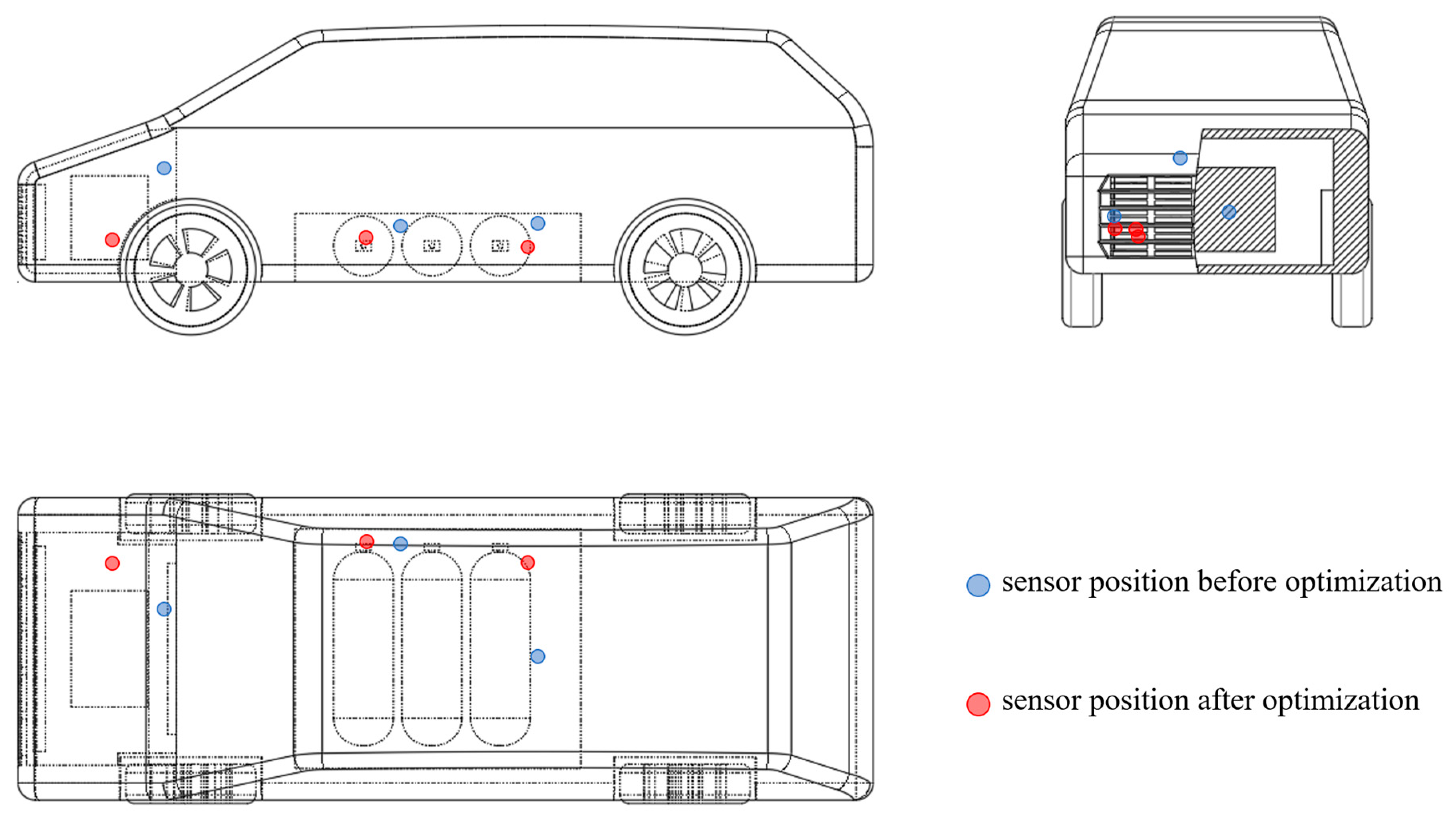

| Projects | Value |
|---|---|
| garage size | 6100 mm × 3640 mm × 2720 mm |
| circular vent center coordinates | (6100 mm, 1820 mm, 2420 mm) |
| circular vent radius | 187 mm |
| rectangular vent center coordinates | (6100 mm, 1820 mm, 170 mm) |
| rectangular vent size | 1220 mm × 90 mm |
| release point coordinates | (4850 mm, 2750 mm, 1000 mm) |
| release direction | +z |
| leakage rate | 1.86 g/s |
| HCSs coordinates | (300 mm, 100 mm, 1900 mm) |
| (2800 mm, 200 mm, 1900 mm) | |
| (2800 mm, 1800 mm, 1900 mm) | |
| (300 mm, 100 mm, 2300 mm) | |
| (2800 mm, 200 mm, 2300 mm) | |
| (2800 mm, 1800 mm, 2300 mm) | |
| (300 mm, 100 mm, 2900 mm) | |
| (2800 mm, 200 mm, 2900 mm) | |
| (2800 mm, 1800 mm, 2900 mm) |
| Parameters | Unit | Specification |
|---|---|---|
| Detectable range | ppm | 1000–40,000 |
| Accuracy | % | ±20 |
| Dimensions | mm | 60 × 56.2 × 15.8 |
| Weight | g | <43 |
| Parameters | Specification |
|---|---|
| Population_size | 100 |
| Crossover_rate | 0.8 |
| Mutation_rate | 0.2 |
| Iterations | 1000 |
Disclaimer/Publisher’s Note: The statements, opinions and data contained in all publications are solely those of the individual author(s) and contributor(s) and not of MDPI and/or the editor(s). MDPI and/or the editor(s) disclaim responsibility for any injury to people or property resulting from any ideas, methods, instructions or products referred to in the content. |
© 2023 by the authors. Licensee MDPI, Basel, Switzerland. This article is an open access article distributed under the terms and conditions of the Creative Commons Attribution (CC BY) license (https://creativecommons.org/licenses/by/4.0/).
Share and Cite
Wang, X.; Yi, F.; Su, Q.; Zhou, J.; Sun, Y.; Guo, W.; Shu, X. Influence of Longitudinal Wind on Hydrogen Leakage and Hydrogen Concentration Sensor Layout of Fuel Cell Vehicles. Sustainability 2023, 15, 10712. https://doi.org/10.3390/su151310712
Wang X, Yi F, Su Q, Zhou J, Sun Y, Guo W, Shu X. Influence of Longitudinal Wind on Hydrogen Leakage and Hydrogen Concentration Sensor Layout of Fuel Cell Vehicles. Sustainability. 2023; 15(13):10712. https://doi.org/10.3390/su151310712
Chicago/Turabian StyleWang, Xingmao, Fengyan Yi, Qingqing Su, Jiaming Zhou, Yan Sun, Wei Guo, and Xing Shu. 2023. "Influence of Longitudinal Wind on Hydrogen Leakage and Hydrogen Concentration Sensor Layout of Fuel Cell Vehicles" Sustainability 15, no. 13: 10712. https://doi.org/10.3390/su151310712
APA StyleWang, X., Yi, F., Su, Q., Zhou, J., Sun, Y., Guo, W., & Shu, X. (2023). Influence of Longitudinal Wind on Hydrogen Leakage and Hydrogen Concentration Sensor Layout of Fuel Cell Vehicles. Sustainability, 15(13), 10712. https://doi.org/10.3390/su151310712







